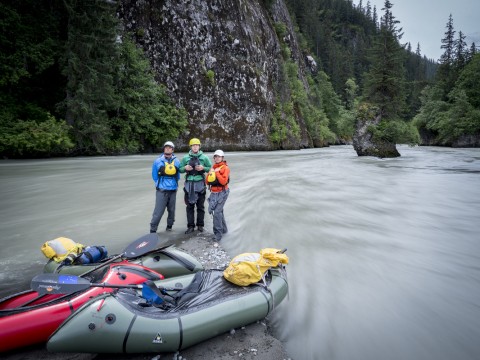
Rafters pose with their inflatable boats during a trip down the Unuk River. (Courtesy Ryan Peterson, Salmon Beyond Borders)
Not a lot of people have traveled the length of the Unuk River.
But Anchorage filmmaker Ryan Peterson has.
Peterson and two others hiked and floated the river from British Columbia’s interior to Misty Fjords National Monument, northeast of Ketchikan.
He says it was a difficult journey through thick forests and sharp lava flows. But he wanted to document the area, which is downstream of several mining projects.
“Every time you look anywhere you see everything from glaciated mountain peaks to wet dripping coastal rain forests, salmonberries, turbid rivers, lava canyons,” he says.
“(It’s) a matrix of tributaries and clear water, salmon spawning habitat, every sort of animal that lives in the coastal forests and the boreal forests inhabits the Unuk’s drainage,” he added.
Peterson says they saw no signs of human habitation until they reached a former mining camp. It wasn’t far from the Kerr-Sulphurets-Mitchell project, a large, open-pit mine permitted for development.
“We started to see garbage. Busted-up plastic drums that had who-knows-what-kind of chemical in them were piled up in logjams. Clorox bleach containers, not so much mining waste as just general garbage from a mining camp,” he says.
“And you know, the thought was just, ‘If they can’t keep their camp clean, what’s that say about their overall ability to keep a gigantic scar in the ground from doing damage?’ ”
That camp belonged to a different exploration company. Developers of the KSM say they keep a clean camp and have built pollution-control systems into their design.
Some of the Unuk River footage is included in Peterson’s short film, called “Xboundary,” which is highly critical of transboundary mine development.





